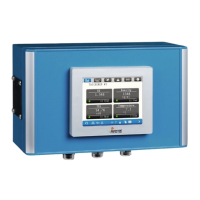User Manual – Arenal PCS – QA03-SDA Page 41/74
6.Calculations
In this chapter an explanation can be found on the background of our measurements.
6.1Temperature
The temperature (T) of the slurry can be measured by an ultrasonic sensor, only when the ultrasonic signals
in the sensor are influenced by a temperature change. It appears that the speed of sound in the probe is
depending on the probe’s temperature. During lab tests the relation between temperature and speed of
sound is determined and the coefficients of a polynomial equation are entered into the ultrasonic
transmitter. As speed of sound is accurately determined, the sensitivity of ultrasonic probes is better than
PT1000 elements.
6.2Density and SG calculation
According to physical laws, the acoustic impedance (Z) is equal to the speed of sound (c) in the liquid and
the density (ρ) of the liquid, as a specific temperature (T). So ρ = Z/c. c is a function (polynomial equation) of
Z and T, so ρ = f(Z, T), or a little different and better: SG = f(Z,T). This is a polynomial equation given in the
ultrasonic transmitter.
Density is calculated by multiplying the SG with the density of water (polynomial equation with the
temperature as an input) at the same temperature.
6.3 TSS calculation
The amount, or weight percent suspended solids, are calculated by the next formula (ref: Wikipedia)
Where,
is the solids fraction of the slurry (state by mass)
is the solids density, entered in the ultrasonic transmitter
is the slurry density, calculated before
is the liquid density, which is as a standard water
In aqueous slurries, as is common in mineral processing, the specific gravity of the species is typically used,
and since is taken to be 1, this relation is typically written:
Even though specific gravity with unit tonnes/m^3 (t/m^3) is used instead of the SI density unit, kg/m^3.
Above function is implemented and can be locally calibrated if needed. As a basis for the calculation, the
model result of SG is used, not the field calibrated value.

